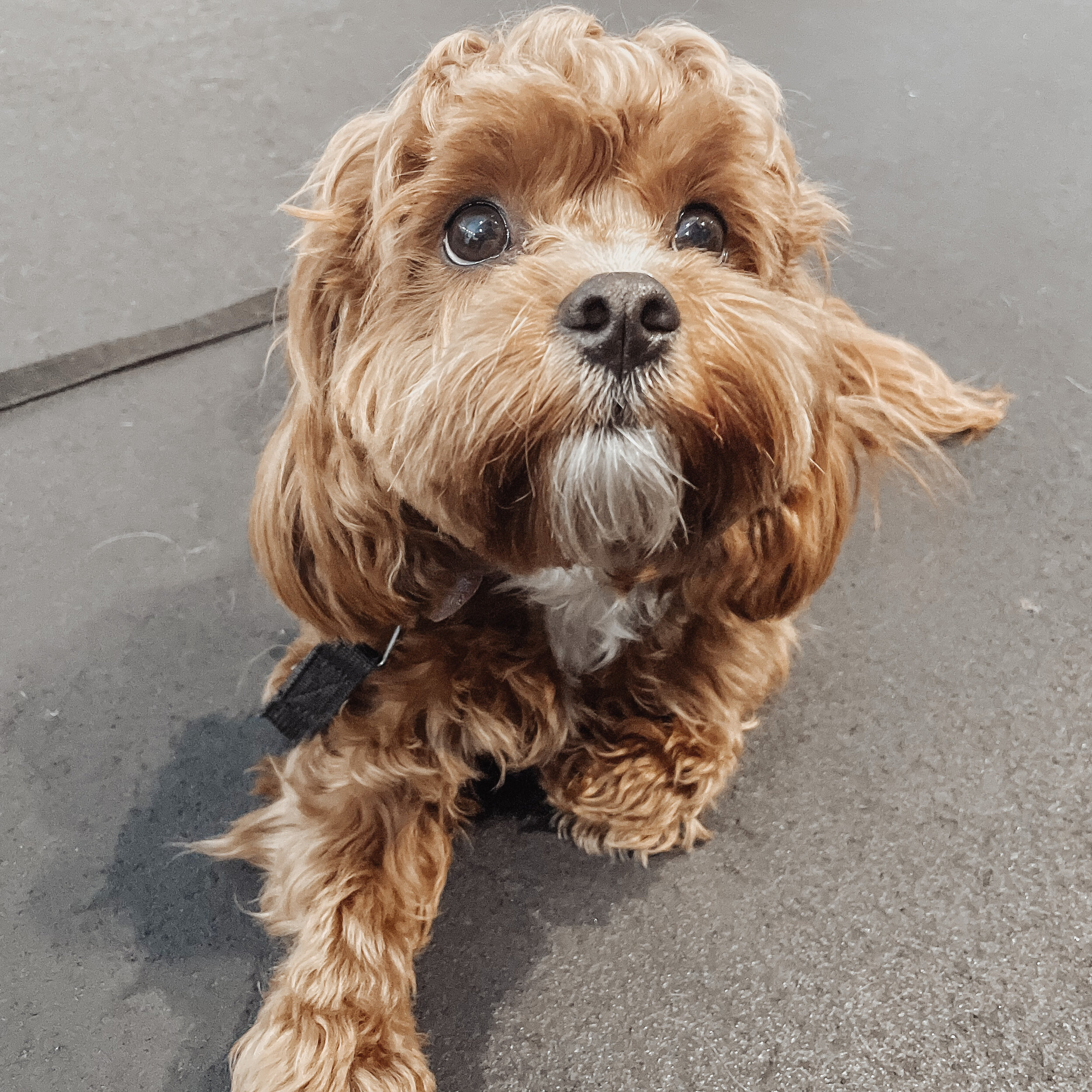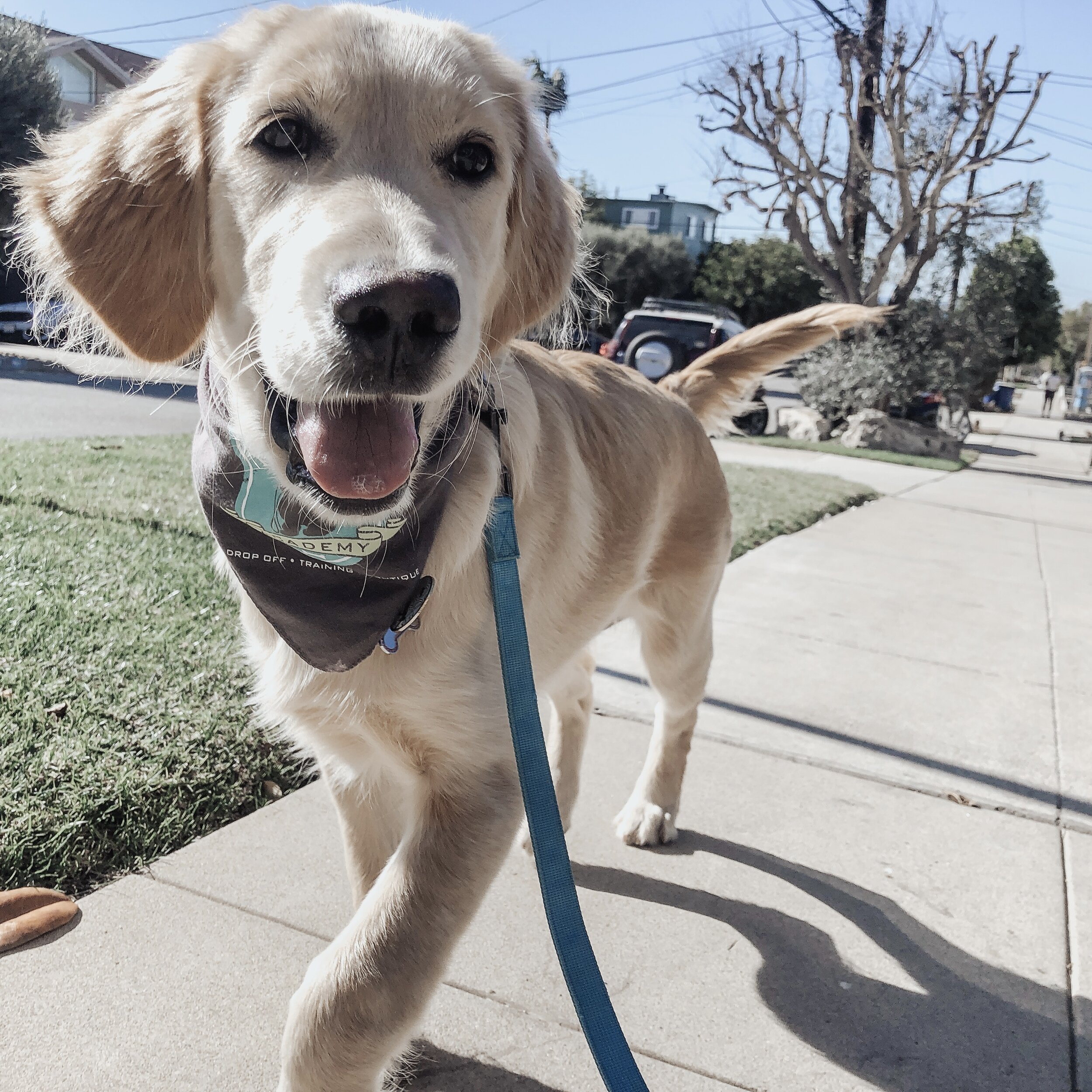So you’ve started getting your puppy used to walking on a leash at home, or even in the yard. Maybe your puppy is even starting to take your lead with the “Let’s Go” routine! Great! Now, let’s talk about setting up real-life walking expectations...
The Puppy Academy student, Penny
Welcome to your introduction to “Heel” command training. At this point, your puppy still may not be able to go for a long walk around your neighborhood, yet! For “Heel” training, start working with your puppy in the living room, hallway, or your front and backyard with as few distractions as possible as your puppy first learns the command. It can take a few weeks before you can go for a full-length walk and expect your puppy to walk on a loose leash next to you. Truthfully, “Heel” is one of the most difficult commands for puppies to learn!
But wait, does that mean you can’t take your puppy for a walk? Absolutely not! And you can start working on “Heel” training right away but just understand that it is something that you need to continue to work on. Your puppy may still be distracted by other dogs, people, cyclists, leaves, etc., and they may still bolt toward those directions! Continue to utilize the “Let’s Go” routine we previously covered to motivate your puppy away from distractions and toward a new direction, then continue to work on “Heel” when the distractions are gone.
Now let’s go into a routine to help get your puppy in the right working mindset and focused on following you so you can start working toward achieving those loose-leash walks with your puppy!
Warm Up Your Puppy for Heel Training
Before working on the “Heel” command training, we recommend that you take a couple of minutes to warm up your puppy with a quick practice session of the “Let’s Go” routine! In case you didn’t read our last blog which introduced getting your puppy used to walking on a leash, here are the simple steps you need to go through this routine:
Start by walking a few steps with your puppy on a harness and leash. When your puppy pulls on the leash, apply light leash pressure to either side of your puppy to get them to switch directions. One thing to remember is that the leash guidance should be applied to the side of your puppy, rather than straight back, which will better help you guide them in the direction you want, instead of creating more resistance. At this point, say “Let’s Go!’ and pat your leg or whistle (whichever works for you and your pup!) to get your puppy’s attention on you. When your puppy starts to change directions and follow you, release the leash pressure and give them slack right away. Now, mark the behavior with “Good!” and reward them with some food. Repeat this routine a few times for up to two to three minutes before moving on to “Heel” training!
Pro tip: During your warm-up session, if your puppy gives you eye contact at any point of the warm-up, mark that behavior with “Good!” and occasionally give them a food reward. Doing this starts to establish that you want your puppy’s focus on you and will become an important tool during Heel training.
NEED HELP TRAINING YOUR PUPPY TO WALK ON A LEASH AND MORE? GET TIPS STRAIGHT TO YOUR INBOX!
Introducing the “Heel” Command
@mille_themountaingirl
What exactly is “Heel”? The goal of “Heel” training is to teach your puppy to follow alongside the heel of your foot on the side they are walking on. While walking forward or, changing directions you will give the command “Heel” to your puppy to keep them alongside you.
As you begin to introduce “Heel”, choose either the left or right side to have your puppy walking beside you. Depending on which side you selected, hold the leash in your hand on that side and pick up the remaining slack with the other hand. Also, have a treat in the hand that is holding your puppy’s leash and closest to your puppy in order to easily regain their attention or quickly reward them. Consider this: your puppy’s nose will follow the treat in your hand! Keeping your arm straight down and hand next to your side will help you keep your puppy in the right walking position instead of behind or ahead of you.
When you start, slowly take a step forward with the foot that is next to your puppy and say “Heel” as your continue stepping forward. After a couple of steps with the puppy moving alongside you, stop, mark the behavior with “Good” and reward your puppy with food. Continue taking just a few slow steps forward and repeat marking the behavior and rewarding your puppy.
Pro tip: As your puppy is still learning, if others in the family will also be walking the puppy, have them pick the same side to walk the puppy! A consistent walking side will help your puppy learn how to “Heel” and prevent them from potentially getting confused and zig-zagging while walking! Eventually, you can switch it up once your puppy fully understands “Heel”.
Heel with Turnarounds From and To Place
If you read the section header and thought, “wait, I thought Heel was for walking not the place command?” You’re right! But puppies can get pretty energetic especially when learning something fun and new! (You can learn more about “Place” command in our previous blog!)
When first introducing “Heel”, start with your puppy on and going to “Place” gives your puppy something to target and focus that energy instead of potentially zooming around you! This goes especially in the beginning when you are still getting the hang of handling your puppy, having your puppy still on “Place” and walking to a “Place” makes the process much smoother!
With your puppy on their “Place”, stand beside them facing away from the cot on the side you wish to walk your puppy on. Now, say the command “Heel” and take a few steps forward with the foot next to your puppy. In this exercise, keep a treat in your hand and in front of your puppy's nose. This will help keep them in the correct walking position! Once your puppy has walked along with you, say “Good!” and give them the food. Again, take a few steps forward and but now turnaround, while saying “Heel”. Continue to keep the food in the same hand and in front of your puppy’s nose as this will help your puppy maintain focus and turns slowly! Mark the correct behavior with “Good!” and give them the reward. Take a few steps forward and say, “Heel”, “Good!”, and give them food. Finally, take a few more steps and say “Heel”, “Place” add a brief pause, then reward your puppy!
Heel with Sit
The Puppy Academy student, Cindy
While still using “Heel” with turnarounds, you can also begin to incorporate “Sit” as a way to momentarily regain your puppy’s attention and get them to settle! Especially when working on “Heel” in a different room, backyard, or any new environment, it’s easy for your puppy to get distracted by what’s happening around them so using “Sit” will help switch their focus back to you.
With your puppy beside you, take one step forward and say “Heel”. At this point, you’ll want to start to slow down. When you do finally stop, lure your puppy into a “Sit” right next to you. If you need a refresh on luring check out our “Puppy Training 101: Starting Your Puppy Off with the Basics! Mark the correct behavior with “Good!”, give your puppy their reward then pause for a second or so. Repeat the sequence, combining this activity with “Heel”, turnaround to “Place”.
Tips to Remember
If this is your first time teaching your puppy “Heel” it’s easy to forget some of these small but important steps. Take note of them in order to make the “Heel” training process easy and keep your puppy’s attention engaged!
Right or Left? Pick one walking side and stick to it! Avoid confusion, zig-zagging, and other trip hazards by teaching your puppy to walk on either your left or right side.
Treat to Nose! The nose knows! Keep a treat in your leash and walking side hand next to you. Your puppy’s nose will be drawn to the treat making teaching them to walk beside you much easier!
Make it a Meal Session! Can your puppy go through a whole meal serving in one training session? Good! Choose one of your puppy’s feeding times and make it their puppy training session to work on “Heel!”
Sit and Settle! “Sit” will help your puppy settle down and refocus on their “Heel” training and turnarounds especially in more distracting environments.
Control the Environment for Controlled Walks! Especially when first introducing your puppy to “Heel”, pick a quiet area where you can best manage the distractions, like your living room or garage. Then as your pup begins getting the hang of "Heel", expand where you practice to new areas like the backyard, driveway, sidewalk outside your house, to eventually down your street. This can take weeks to achieve, so don't rush the process!
“Heel” training your puppy is one of the more challenging commands and a major milestone for puppies to achieve! Consistency and patience are the two most important tips for “Heel” training and all puppy training in general! Keep your puppy training sessions up to fifteen minutes long each day, building on your puppy’s most basic obedience commands, working up to more advanced “Heel” with turnarounds. As your puppy matures and learns to work through distractions, you can begin to really push their skills to the next level by bringing them to new environments to practice!
Check out these blogs related to puppy training and more!
Puppy Training 101: Introduction to Walking on a Leash!
Puppy Training 101: Teaching Your Puppy Place Command Routines!
Puppy Training 101: How to Get Your Puppy Responding to Come!







